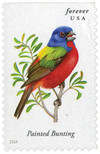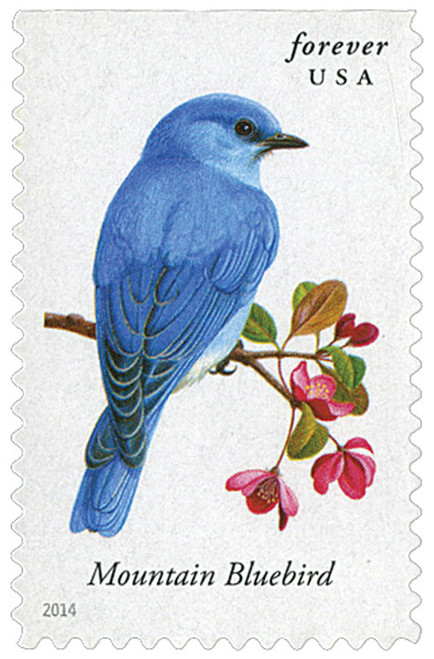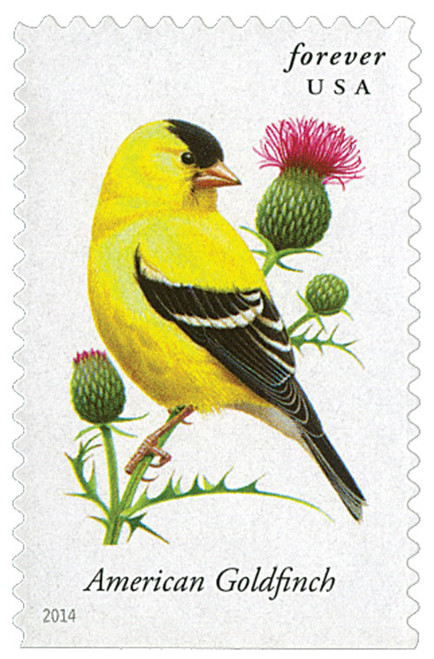
# 4885 - 2014 First-Class Forever Stamp - Songbirds: Painted Bunting
US #4885
2014 Painted Bunting – Songbirds
- Pictures a painted bunting
- One of 10 stamps picturing different species of songbird
Stamp Category: Commemorative
Set: Songbirds
Value: 49¢ First Class Mail Rate (Forever)
First Day of Issue: April 5, 2014
First Day City: Dallas, Texas
Quantity Issued: 400,000,000
Printed by: Ashton Potter (USA) Ltd.
Printing Method: Offset
Format: Double-sided Booklets of 20
Tagging: Nonphosphored Type III, Overall Tagged
Why the stamp was issued: To commemorate the painted bunting and its unique song.
About the stamp design: Pictures a painting of a painted bunting perched on thin, leafy branch. Artwork by Robert Giusti. The stamp also includes the species’ common name.
First Day City: In addition to the Dallas, Texas, First Day of Issue city, there was also a First Day of Sale ceremony held at the Philadelphia National Stamp Exposition in Oaks, Pennsylvania. They offered two different pictorial postmarks: one from Oaks and one from nearby Audubon, Pennsylvania. The pictorial cancels were designed by the American First Day Cover Society.
About the Songbirds set: Issued to commemorate the many species of songbirds that call America home and fill the air with the sounds of their unique tunes. Includes 10 different designs, each picturing a different species of songbird and its’ common name: western meadowlark, mountain bluebird, western tanager, painted bunting, Baltimore oriole, evening grosbeak, scarlet tanager, rose-breasted grosbeak, American goldfinch, and white-throated sparrow. In addition to the birds themselves, the stamps also picture different plants (often found in the birds’ natural habitats) acting as perches. Designs were created from paintings by Robert Giusti.
History the stamp represents: The painted bunting is perhaps the most colorful of the North American songbirds. The more colorful males are bright blue, green, yellow, and red, while the females exhibit bright-green hues. This medium-sized finch is common in the southeastern to south-central United States and throughout Mexico, with wintering habitats stretching south throughout Central America.
Despite its vivid plumage, the painted bunting is not always easy to spot. It usually makes its tiny nests in dense thickets, briar patches, and brushes, obscuring it from sight. It also spends a good deal of time foraging for seeds at ground level, further hiding it from view. It can most often be seen during breeding season as it flies up to catch insects or fight off competitors.
The male painted bunting is an aggressive defender of his approximately three-acre turf. If necessary, he will fight other males to the death to protect his territory. Unfortunately, this characteristic also makes the male vulnerable to human capture.
In the mid-19th century, John Audubon noted that thousands of painted buntings were tricked into attacking decoys and shipped to Europe as cage birds. This practice continues in Mexico and Central America despite federal protection.
US #4885
2014 Painted Bunting – Songbirds
- Pictures a painted bunting
- One of 10 stamps picturing different species of songbird
Stamp Category: Commemorative
Set: Songbirds
Value: 49¢ First Class Mail Rate (Forever)
First Day of Issue: April 5, 2014
First Day City: Dallas, Texas
Quantity Issued: 400,000,000
Printed by: Ashton Potter (USA) Ltd.
Printing Method: Offset
Format: Double-sided Booklets of 20
Tagging: Nonphosphored Type III, Overall Tagged
Why the stamp was issued: To commemorate the painted bunting and its unique song.
About the stamp design: Pictures a painting of a painted bunting perched on thin, leafy branch. Artwork by Robert Giusti. The stamp also includes the species’ common name.
First Day City: In addition to the Dallas, Texas, First Day of Issue city, there was also a First Day of Sale ceremony held at the Philadelphia National Stamp Exposition in Oaks, Pennsylvania. They offered two different pictorial postmarks: one from Oaks and one from nearby Audubon, Pennsylvania. The pictorial cancels were designed by the American First Day Cover Society.
About the Songbirds set: Issued to commemorate the many species of songbirds that call America home and fill the air with the sounds of their unique tunes. Includes 10 different designs, each picturing a different species of songbird and its’ common name: western meadowlark, mountain bluebird, western tanager, painted bunting, Baltimore oriole, evening grosbeak, scarlet tanager, rose-breasted grosbeak, American goldfinch, and white-throated sparrow. In addition to the birds themselves, the stamps also picture different plants (often found in the birds’ natural habitats) acting as perches. Designs were created from paintings by Robert Giusti.
History the stamp represents: The painted bunting is perhaps the most colorful of the North American songbirds. The more colorful males are bright blue, green, yellow, and red, while the females exhibit bright-green hues. This medium-sized finch is common in the southeastern to south-central United States and throughout Mexico, with wintering habitats stretching south throughout Central America.
Despite its vivid plumage, the painted bunting is not always easy to spot. It usually makes its tiny nests in dense thickets, briar patches, and brushes, obscuring it from sight. It also spends a good deal of time foraging for seeds at ground level, further hiding it from view. It can most often be seen during breeding season as it flies up to catch insects or fight off competitors.
The male painted bunting is an aggressive defender of his approximately three-acre turf. If necessary, he will fight other males to the death to protect his territory. Unfortunately, this characteristic also makes the male vulnerable to human capture.
In the mid-19th century, John Audubon noted that thousands of painted buntings were tricked into attacking decoys and shipped to Europe as cage birds. This practice continues in Mexico and Central America despite federal protection.














